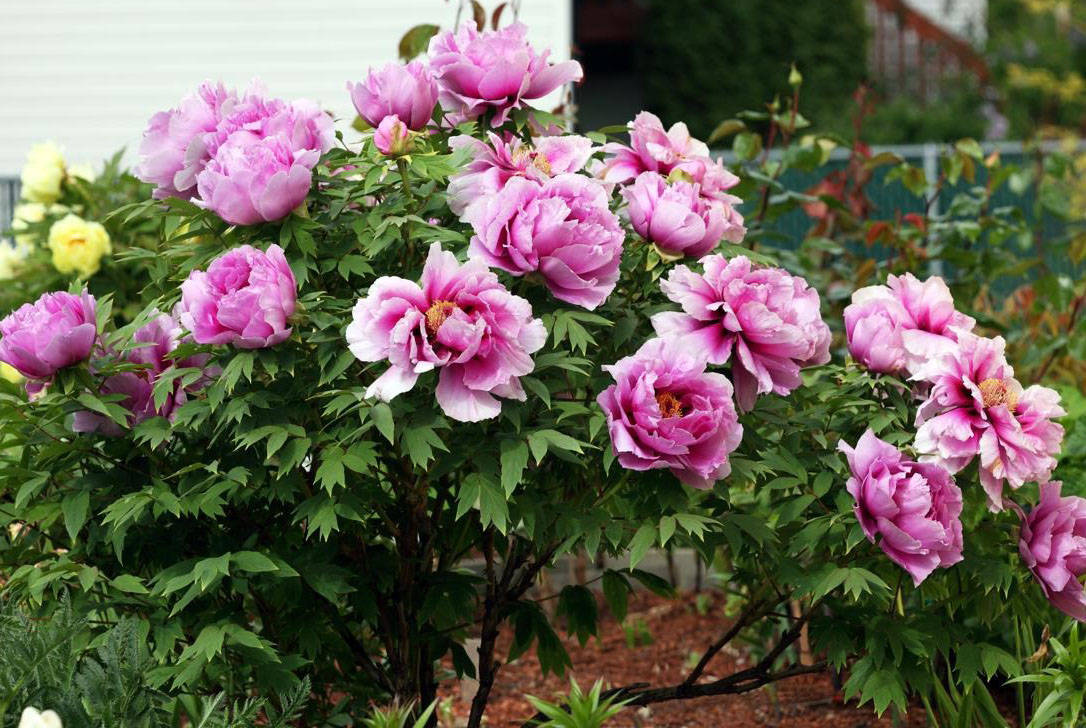Peony is a plant that has many varieties and species, each of which is unique. One of its varieties is the marin root or dodging peony. It is herbaceous and grows about a meter.
Below we will talk about what is unique about the peony Maryin root, what are its features and properties.
Content
The appearance of the marin root and habitat
Peony marin root grows mainly in the European part of Russia and Siberia... Among other regions of its habitat:
- Ural;
- Middle Asia;
- Kazakhstan.
It is found in areas such as:
- taiga meadows;
- edges;
- glades;
- glades.
The plant belongs to the category of perennials, its height can reach a meter or more. Evasive peony has a powerful rhizomeand its roots are thick and reddish brown. Peony stems are erect, they have 3-5 leaflets about 30 cm long and about 30 cm wide. Large red flowers about 15 cm in diameter consist of 5 petals.
Description of Mary's root
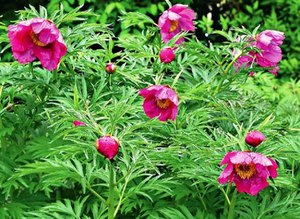 Maryin's root or peony, which shies away, is also popularly called Mary's grass or heart berries. He differs in shade tolerance, grows well on loose fertile soils.
Maryin's root or peony, which shies away, is also popularly called Mary's grass or heart berries. He differs in shade tolerance, grows well on loose fertile soils.
Maryin root has the following distinctive characteristics:
- flowers have a pink-purple hue and are located at the top of the stem;
- leaves have a complex shape;
- peony bloom lasts from the second half of May to the end of June, in August it bears fruit;
- the plant reproduces in a vegetative and seed way.
In some countries, this plant, which has the ability to evade, is very rare, therefore it is listed in the Red Book. Also, Maryin root is used for medicinal purposes, and not only in non-traditional healing methods, but also in official medicine.
Features of growing a peony evading in garden conditions
Maryin root has been cultivated as a garden plant for more than one century, therefore experienced gardeners know many secrets regarding its cultivation and care. Like other varieties of peony, the one that shirks can be grown as an ornamental plant to decorate a garden or create a composition, as well as for medicinal purposes.
The root in terms of cultivation is not too demanding, you can plant it in places such as:
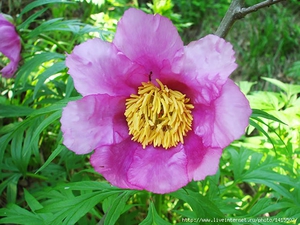 in the sun;
in the sun;- in the shadow;
- next to ornamental or fruit trees.
Also, the peony is not particularly picky about the soil, but it should be moderately moist and loose. Avoid excess moisture in the soil and drafts. The roots of the plant are powerful enough, and all the moisture accumulates there, so modest watering will be enough.
Basic rules of care
When growing Mary's root, it is recommended to follow these rules:
- to plant a peony that evades, you need to by the end of August or at the beginning of September, while the buds need to be buried a maximum of 5 cm, the flower is not covered for the winter;
- during the first three years after planting the marin root, make sure that the soil is always loose;
- loosening is carried out throughout the growing season, when weeds appear, they must be immediately removed, since they draw all nutrients from the soil, block the flow of air and provoke diseases;
- after precipitation, make sure that there are no crusts on the soil. Young peonies loosen to a depth of 5 cm, and adults - 15 cm, respectively;
- three years after planting, the peony needs to be pinned. Leave a couple of buds on the bush, remove the rest, also cut off the faded flowers. Support dense bushes;
- the transplanted marin root will bloom after 2 or 3 years, every year it tends to bloom brighter and denser. Do a transplant no more than once every three years.
Plant propagation
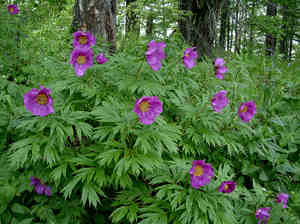 The evading peony reproduces in several ways:
The evading peony reproduces in several ways:
- layering;
- dividing the bush and rhizomes;
- seeds;
- cuttings.
The easiest way is to divide by rhizome. To do this, you need to pick up middle-aged bushes and divide them in such a way that each one has 3 annual shoots.
With seed reproduction you need to plant them in late autumn, the first shoots will appear in the spring, but the mariin root will bloom only after a few years.
If you plant sprouts in holes, you need to lay a large layer of manure of about 20 cm, then go:
- compost 10 cm;
- soil based on superphosphate and bone meal.
- Divided bushes should be mulched with peat.
Further plant you need to regularly loosen, weed, water and periodically feed.
When planting and growing a dodging peony, consider the following:
- for the first time, the plant is fed in the spring after the first shoots appear. Under each bush you need to add 70 g of nitroammophoska;
- top dressing is laid out according to the diameter of the bush and sprinkled;
- seeds germinate slowly due to poorly developed embryos, but this is the only way to sow a large number of bushes at the same time;
 stratification is performed in 2 stages;
stratification is performed in 2 stages;- first, the seeds should be in moistened sand for 2 months at a temperature of about 25 degrees, then 2 months at a temperature of 5 degrees, respectively;
- then they are sown into the ground to a depth of about 3 cm;
- with an active growing season, boron and manganese must be added to the soil.
Before flowering, mullein infusion can also be added and supplemented with potash or phosphorus fertilizer.
In September, cut off the aerial part of the plant, leaving shoots up to 15 cm near the roots. Humus is added under each peony and the bushes are mulched.
How to prepare raw peony
Raw materials of the aerial part of the flower and its roots must be procured separately and at different times... The aerial part is collected during flowering in the month of July. It is carefully cut with a knife, if you tear it off, you can damage the kidneys.
But the roots for raw materials can be harvested at any time of the year, but it is best to do this in the fall. When the aerial part of the plant withers, the maximum amount of nutrients goes into the roots.
To begin with, the roots are shaken off of dirt, and then washed and left for several days in a warm place in order to wither. Then, for fragility, the roots are transferred to a dryer, the temperature of which should be maximum 50 degrees. A strong smell will come from the rootsbut they taste astringent and sweet. To get the same amount of dry product per kilogram of raw roots, you need to prepare 2 kg of raw aerial part of the plant.
Peony raw materials must meet the following parameters:
- the length of rhizomes and some roots is 1–9 cm;
- thickness 21.5 cm;
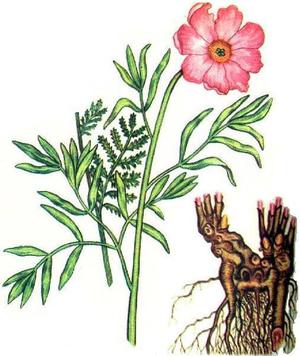 yellow-brown or brown tint;
yellow-brown or brown tint;- the color of the root when fractured should be light yellow;
- the smell is pungent;
- the taste is sweet and astringent;
- 13% moisture;
- 10% ash;
- short roots - 10%;
- impurities in the form of sand, earth, stones - 1 percent;
- the aerial part of the peony should consist of leaves, buds, flowers and stems.
Raw materials are stored for up to three years, during this period it has the most valuable properties.It must be collected and applied carefully, since the composition of the evading peony contains poisonous components.
However, in addition to this, it also contains useful components:
- essential oil;
- biological active substances;
- vitamin C.
Useful properties and application in traditional medicine
The peony, which has a tendency to shy away, is often used in folk medicine. On its basis, a tincture is made, which is used for a large number of different diseases.
In some countries, not only medicinal, but also magical properties are attributed to the marin root. For example, in China, this flower is considered a symbol of prosperity, also with its help, according to legend, you can drive away nightmares and wear around the neck against epilepsy... And in Armenia there is a belief that a peony can expel dark forces from a person. In European countries, it was applied to the heart to cure some diseases.
The evading peony is used not only for the treatment of people but also for animals. So, decoction based on it helps to improve pet's appetite, relieve stomach upset and pain, treat colic, ulcers, liver and other diseases.
At different times, this plant was prescribed for the treatment of various ailments. To date, it is known that peony helps in cases such as:
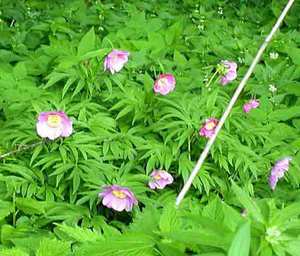 as a sedative and anticonvulsant;
as a sedative and anticonvulsant;- vegetative-vascular diseases;
- sleep disorders;
- neuroses and hypochondria;
- some types of cancer;
- high blood pressure;
- metabolic disease;
- tuberculosis;
- pneumonia;
- kidney problems;
- headache;
- cervical erosion;
- malaria;
- hemorrhoids;
- diseases of the liver and stomach.
But when using this type of peony for medicinal purposes, it is worth remembering that it has its own contraindications. As mentioned earlier, it contains toxic substances, so you need to strictly observe the dosage and duration of use. It is strictly prohibited use the remedy in any form for women during pregnancy and children under 12 years of age. It is not recommended to take peony during hypotension or hyperacid gastritis, or only on the recommendation of a doctor.
The active ingredients of peony resemble amidopyrine, which has an anti-inflammatory effect.
Tincture of maria roots is made on the basis of the roots and aerial parts of the plant in dried form... It is taken in a teaspoon three times a day for a month with vegetative dystonia, physical and intellectual exhaustion, lethargy, insomnia, and also with increased excitability.
As you can see, peony Maryin root is not only a plant that able to decorate the garden, but also a good medicine that helps with a number of diseases.
